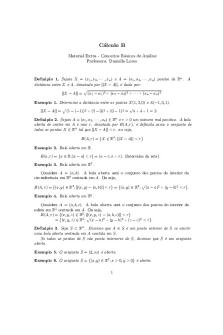Survey-IMF-2020 - This is extra material for practice PDF

| Title | Survey-IMF-2020 - This is extra material for practice |
|---|---|
| Author | Adeola Adeleye |
| Course | Organic Chem 1 Wksp |
| Institution | The City College of New York |
| Pages | 3 |
| File Size | 126 KB |
| File Type | |
| Total Downloads | 97 |
| Total Views | 139 |
Summary
This is extra material for practice...
Description
Please DO NOT write your name on this questionnaire Rank the following in order of increasing boiling points.
3
1
6 5 2
4
What strategies did you use to solve the above problem? Please explain. • • •
I looked for the number of carbons, generally more carbons means higher boiling point I looked for hydrogen bonding and dipole- dipole interactions I looked for the number of branches. More branches means the molecule has a lower boiling point
Identify the main intermolecular forces (IMFs) in the following molecules: London dispersion H2SO4 Hydrogen
Hydrogen
NaCl Dipole- Dipole
Dipole- Dipole London dispersion
What strategies did you use to identify the IMFs in the molecules shown above? Please explain.
•
London dispersion forces are usually in nonpolar molecules
•
Hydrogen bonding usually occurs within hydrogen and fluorine, oxygen or nitrogen
•
Dipole- dipole forces are usually between polar covalent molecules
Arrange the following molecules from lower to greater Dipole-Dipole interaction. H—F H—Br H—I H—Cl
H—I < H—Br < H—Cl< H—F List some challenges you faced while learning about Intermolecular Forces. •
Determining which elements are there by looking at the structures
Why do you think IMFs problems are challenging? Can you give an example? Intermolecular forces problems may be challenging when you don’t really understand the difference between dispersion forces, dipole dipole forces and hydrogen bonding. You would have difficulty labeling something as a dipole dipole interaction if you can’t tell whether or not the molecule is polar or nonpolar. Dipole dipole interactions usually occur between polar covalent molecules.
How do you think you can improve your learning and understanding of IMFs. I would have to continue doing practice problems on them to deepen my understanding.
Can you give a thorough explanation on how to solve for intermolecular forces problem? To solve an intermolecular force problem, you would have to look at the molecule or structure and determine what bonds it has and whether is it polar or nonpolar. Nonpolar molecules would most likely have dispersion forces. Molecules bonded to hydrogen like fluorine, nitrogen, and oxygen would be hydrogen bonding. Dipole dipole interactions would be between covalently bonded structures.
For the following questions please select the box that is most appropriate: Intermolecular Forces are a difficult part of chemistry. ☐ Strongly Disagree ☐ Disagree ☒ Neutral ☐ Agree ☐ Strongly Agree
I am unsure when performing an IMFs problem. ☐ Strongly Disagree ☐ Disagree ☒ Neutral
☐ Agree
☐ Strongly Agree
Memorization was a large part of learning about IMFs. ☐ Strongly Disagree ☒ Disagree ☐ Neutral
☐ Agree
☐ Strongly Agree
Lewis Structures are important for solving questions about IMFs. ☐ Strongly Disagree ☐ Disagree ☐ Neutral ☐ Agree
☒ Strongly Agree...
Similar Free PDFs

Material extra
- 2 Pages

This is for Handout
- 4 Pages

Material extra Office 365
- 14 Pages

practice material for students Docx
- 12 Pages

practice Material ....
- 8 Pages

Extra Practice Week 9
- 2 Pages

This is Matlab 3 for math 20d
- 6 Pages
Popular Institutions
- Tinajero National High School - Annex
- Politeknik Caltex Riau
- Yokohama City University
- SGT University
- University of Al-Qadisiyah
- Divine Word College of Vigan
- Techniek College Rotterdam
- Universidade de Santiago
- Universiti Teknologi MARA Cawangan Johor Kampus Pasir Gudang
- Poltekkes Kemenkes Yogyakarta
- Baguio City National High School
- Colegio san marcos
- preparatoria uno
- Centro de Bachillerato Tecnológico Industrial y de Servicios No. 107
- Dalian Maritime University
- Quang Trung Secondary School
- Colegio Tecnológico en Informática
- Corporación Regional de Educación Superior
- Grupo CEDVA
- Dar Al Uloom University
- Centro de Estudios Preuniversitarios de la Universidad Nacional de Ingeniería
- 上智大学
- Aakash International School, Nuna Majara
- San Felipe Neri Catholic School
- Kang Chiao International School - New Taipei City
- Misamis Occidental National High School
- Institución Educativa Escuela Normal Juan Ladrilleros
- Kolehiyo ng Pantukan
- Batanes State College
- Instituto Continental
- Sekolah Menengah Kejuruan Kesehatan Kaltara (Tarakan)
- Colegio de La Inmaculada Concepcion - Cebu








